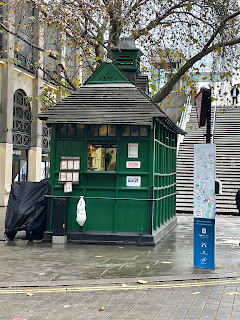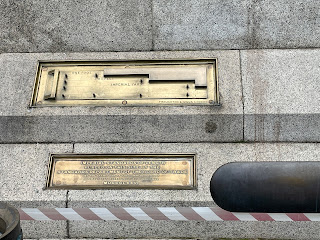And Now For Something Completely Different.
London 11/30
We had an uneventful day traveling from Dover to London yesterday. Arrived early at hotel and waited a bit for the room to be readied. Got settled and walked about he neighborhood.
Stopped in the Stanhope Arms for a bit of food. Had a nice chat with a gentleman about the disappearing true public houses. He was so kind as to provide some suggestions. FYI there are many chain pubs these days, Green King and Witherspoons. They are ok but not great. Just me.
Called it a night after organizing our paperwork of places we may want to visit.
Today we were up and out the door to our Underground station, taking the Central Line to Embankment. Our first destination is the National Gallery to find a bit of Monty Python trivia. We decided to not travel by Underground all the way and walked from Embankment.
To my surprise, (not really as I have been there many a time,) there is a cabbie shelter there. I got us a Bacon Butty to have for lunch later this day. For £2.50 it makes a great lunch. We then walked to the National Gallery.
Hanging in London’s National Gallery is another painting of Cupid and Venus, made for yet another King of France. The painting is Bronzino’s Mannerist masterpiece An Allegory with Venus and Cupid, made in the 1500s for King Francis I. The piece hangs large alongside works by Michelangelo and Raphael, depicting with great detail and texture, Cupid kissing his mother Venus.
We also took some time to appreciate many of the various masterpieces.
Hundreds of years after Bronzino created his allegorical painting, a young animator working on a British television show wandered the museums of London looking for inspiration and imagery to use for his work. The animator was the gifted Terry Gilliam and the show was the epic comedy series Monty Python’s Flying Circus.
If you look carefully at the bottom lefthand corner of the painting, you may notice that Cupid’s foot is the emblematic Monty Python foot—you know, the giant foot that randomly stamps down from the heavens obliterating objects beneath it. You may recognize the foot from the Flying Circus’s animated title sequence: At the end of the opening, the giant foot descends and crushes the title. The foot became a trademark icon for the Monty Python comedy troupe.
It was here in the National Gallery that Gilliam saw the wonderful, huge Bronzino painting and borrowed Cupid’s foot for TV. Indeed, this is something Gilliam did quite frequently.
It wasn’t until 1859 that free, public drinking water became a “thing.”
That’s when The Metropolitan Drinking Fountain and Cattle Trough Association was established in London. Before its inception, private water companies monopolized the precious liquid, rarely providing enough of it, and what they did provide was rarely drinkable. In 1854, it was also a little heavy on the cholera, as was discovered by John Snow when he traced the epidemic to what is now lovingly known as The Broad Street Cholera Pump.
Old Bailey, Criminal Courts Building
Lunch Time.
Regulation and a movement of sorts in favor of public access to water led to the government finally being able to buy out the private water companies, and the first public baths and drinking fountains began popping up in Liverpool, philanthropic citizens were urged to take up the cause.
Philanthropist Samuel Gurney heard the call, and built the first fountain on Holborn Hill, a simple granite basin attached to the gates of St. Sepulchre-without-Newgate Church. Keeping a close eye on standards, as required by the Metropolitan Drinking Fountain and Cattle Trough Association that “no fountain be erected or promoted by the Association which shall not be so constructed as to ensure by filters, or other suitable means, the perfect purity and coldness of the water.”
Well, the fountain and its refreshing purpose became instantly popular, and soon 7,000 people were stopping by for a drink every day. Clearly, the demand was high, and more fountains popped up, as many as 85 in the next six years. There was some funding by donation, but Samuel Gurney footed most of the bill.
The Gurney’s original fountain includes two cups chained for drinking. The new drinking fountain idea took off from there and went on to include elaborate wells designed by leading architects of the day. It was moved from the gates of St Sepulchre-without-Newgate Church in 1867 when the Holborn Viaduct was built, but reinstated in 1913 where it remains to this day.
More obscure WWII history from the Blitz was next. Our next stop is at the Borough Station on the District Line. Here, at short walk away, we find the Stretcher Fences.
These fences were originally emergency stretchers used by Air Raid Protection officers. The officers would put those injured during the Blitz onto the stretchers and carefully haul them off toward safety.
It’s clear that the government anticipated such medical equipment would be needed, as more than half a million stretchers were produced in the years before World War II began. The stretchers, which were no more than two steel poles flanking a stretch of wire mesh, were quick to mass produce. They were also easier to clean/decontaminate than conventional wood or canvas stretchers.
During the war, many of London’s housing estates lost their original metal railings when they were manufactured into weaponry to serve the war effort. With a large stockpile of stretchers following the war, the London City Council decided to have the stretchers welded vertically together, fixed onto poles, sunken into concrete, and used to replace this missing fencing. The two kinks in the poles, designed so that they could be rested on the ground then picked up easily.
Then, to our surprise, we located the Roebuck Pub, a nice local public house where Truman Beers are served. The Truman Brewery is located near Spitalfields Market and Truman Brewery Markets. We had a nice little break there, the young bartender is trying to plan a trip to the western US for some solitude. A nice stop.
Leaving the Slone Square Station we encounter these school lads singing carols to raise funds for a local hospital.
Next stop a bit of Supercalifragilistic Mary Poppins. We were off to 50 Smith Street in Chelsea. There’s an English Heritage Blue Plaque marking the real-life house of Mary Poppins author, P.L. Travers. It’s said that Travers’ Chelsea home influenced the Banks’ Cherry Tree Lane address.
The kind gentleman we met the night before suggested a pub near where we were. This is the Fox and Hounds, a nice corner local pub, small and friendly. There we received a recommendation for food at The Antelope pub. We walked to The Antelope only to learn their kitchen was not open for another hour and one half. We made our way back to our hotel, settling for Italian before calling it a day.






















































